History: CBSE Sample Question Paper (2020-21) - 4 | History Class 12 - Humanities/Arts PDF Download
Class - XII
History
TIME: 3 Hrs.
M.M: 80
General Instructions:
(i) Answer all the questions. Some questions have an internal choice. Marks are indicated against each question. This question paper comprises of six section.
(ii) Section A - Question numbers 1 to 16 are objective type questions, carrying 1 mark and should be answered in one word or one sentence each (Attempt any 15).
(iii) Section B - Question numbers 17 to 19 are Case based/Source based having multiple Choice questions. Each question has 4 sub-parts. Attempt any three sub-parts from each question.
(iv) Section C - Answer to questions carrying 3 marks (Question 20 to 23) should not exceed 100 words each.
(v) Section D - Answer to questions carrying 8 marks (Question 24 to 26) should not exceed 350 words each.
(vi) Section E - Question number 27 to 29 are Source-based questions carrying 5 marks each.
(vii) Section F - Question number 30 is a Map question that includes the identification and location of significant test items. Attach the map with the answer book.
SECTION A
Attempt any 15 questions.Q.1. What is “Chert ? (1 Mark)
Ans. Chert is a type of stone used to make standardized weights.
Q.2. Whom did Ashoka appoint to spread the message of Dhamma? (1 Mark)
Ans. Appointed special Officers were called dhamma mahamatta.
Q.3. Read the following information and mention the context in which the statement is connected : (1 Mark)
“The concern with patriliny was not unique to ruling families.”
Ans. The ideal of Patriliny.
Q.4. Read the following information and mention the context in which the statement is connected : (1 Mark)
“They fiercely resisted efforts of Zamindars to increase the Jama of the village.”
Ans. The rise of the Jotedars.
Q.5. Periplus in Greek means: (1 Mark)
(a) Act of bread making
(b) Sailing around
(c) Bead Making
(d) Ships
Ans. b
Q.6. Correct the following statement and rewrite it: (1 Mark)
According to Jainism, asceticism and the middle path are required to free oneself from the cycle of Karma.
Ans. According to Jainism, asceticism and the penance are required to free oneself from the cycle of Karma.
Q.7. Define ‘Didactic’. (1 Mark)
Ans. Didactic refers to something that is meant for the purpose of instruction.
Q.8. Identify the following image : (1 Mark)
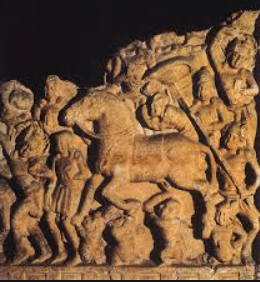 Ans. A sculpture from Amaravati (Andhra Pradesh), depicting the departure of the Buddha from this place.
Ans. A sculpture from Amaravati (Andhra Pradesh), depicting the departure of the Buddha from this place.
Q.9. Correct the following statement and rewrite it : (1 Mark)
“Hajj is an Imperial Order.”
Ans. Farman is an Imperial Order.
Q.10. Given below are two statements, one labelled as Assertion (A) and the other labelled as Reason (R) : (1 Mark)
Assertion (A): Archaeologists suggest that in the north-eastern corner of the urban core rich traders lived.
Reason (R): Numerous tombs, mosques, and fine Chinese porcelain have been found here.
(a) Both (A) and (R) are correct and (R) is the correct explanation of (A)
(b) Both (A) and (R) are correct, but (R) is not the correct explanation of (A)
(c) (A) is correct, but (R) is not correct
(d) (R) is correct, but (A) is not correct
Ans. a
Q.11. Correct the following statement and rewrite it : (1 Mark)
In Kanpur, the Sepoys and the people of the town gave Kunwar Singh, no choice save to join the Revolt as their leader.
Ans. In Kanpur, the Sepoys and the people of the town gave Nana Sahib, no choice save to join the Revolt as their leader.
Q.12. Who are Ulemas ? (1 Mark)
Ans. Ulama are the scholars of Islamic studies.
Q.13. On whose behalf did the Vijayanagara kings claim to rule? (1 Mark)
Ans. God Virupaksha
Q.14. Match the following: (1 Mark)

Options:
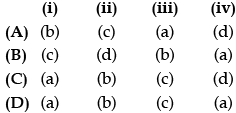
Ans. b
Q.15. Identify the following image : (1 Mark)
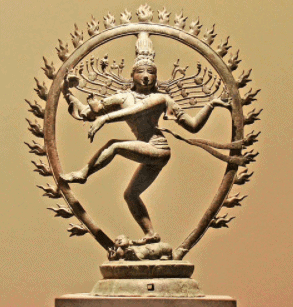
Ans. An image of Shiva as Nataraja.
Q.16. In the popular tradition of Vijayanagara, the Rayas are termed as ............ . (1 Mark)
Ans. Narapati
SECTION B
Q.17. Read the following excerpt carefully and answer any three questions : (3 Mark)Why were Stupas Built ?
This is an excerpt from the Mahaparinibbana Sutta, part of the Sutta Pitaka. As the Buddha lay, dying Ananda asked him “What are we to do Lord, with the remains of the Tathagata (another name for the Buddha) ?” The Buddha replied, “Hinder not yourselves Ananda by honouring the remains of the Tathagata. Be zealous, be intent on you own good.”
But when pressed further, the Buddha said, “At the four crossroads, they should erect a thupa (Pali for stupa) to Tathagata. And whosever shall there place garlands or perfume.....or make a salutation there, or become in its presence calm of heart, that shall long be to them for a profit and joy.”
(a) Stupas are associated with :
(i) Jainism
(ii) Buddhism
(iii) Hinduism
(iv) None of the above
Ans. ii
(b) Stupas were built because the relics of Buddha such as his bodily remains or objects used by him were:
(i) Burned there
(ii) Buried there
(iii) Destroyed there
(iv) None of the above
Ans. ii
(c) Ashoka distributed portions of Buddha’s relics to every important town and ordered the construction of :
(i) Stupas over them.
(ii) Temples over them.
(iii) Churches over them.
(iv) None of the above.
Ans. i
(d) Anda is a :
(i) Balcony-like structure that represented the abode of the Gods.
(ii) Railing which separated the sacred place from the secular world.
(iii) Semi-circular mound of Earth.
(iv) None of the above.
Ans. iii
Q.18. Study this Mughal painting entitled Jahangir’s dream carefully and answer any three of the following questions by choosing the correct option: (1+1+1 = 3)
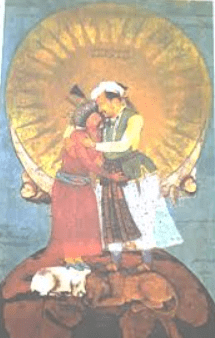 (a) This Mughal painting is given the name of Jahangir ’s dream because:
(a) This Mughal painting is given the name of Jahangir ’s dream because:
(i) It shows the two rulers Jahangir and Safavid Shah Abbas in a friendly embrace which was Jahangir’s desire.
(ii) It gave a sense of authenticity to a scene which was fictional as the two rulers had never met.
(iii) An inscription on this miniature records that Jahangir commissioned Abu’l Hasan to render in painting a dream the Emperor had recently seen.
(iv) All of the above.
Ans. iv
(b) The animals seen in the painting stand for:
(i) A realm in which both the strong(lion) and the weak (lamb) exist in harmony.
(ii) An ideal world where animals and humans live together.
(iii) Both (i) and (ii)
(iv) None of the above.
Ans. i
(c) The globe beneath the feet of both the Emperors suggests:
(i) The dream of Jahangir (the world seizer) to conquer the whole world by embracing his rival Shah Abbas.
(ii) The globe is used by the painter to provide depth to the painting.
(iii) The globe is representing the ideal world of humans and animals existing together.
(iv) Both (ii) and (iii)
Ans. i
(d) A comparison of the physique and posture of both the Emperors in the painting portrays:
(i) The superiority of Jahangir over Shah Abbas as shown by the difference in the physical size of their respective portraits.
(ii) The dream of Jahangir of embracing his rival Shah Abbas in a friendly manner to retain Qandhar.
(iii) Both (i) and (ii)
(iv) None of the above.
Ans. iii
Q.19. Read the following text and answer any three of the following questions : (3 Mark)
Apart from wives, numerous male and female slaves populated the Mughal household. the tasks they performed varied from the most mundane to those requiring skill, tact and intelligence. Salve eunuchs (khwajasara) moved between the external and internal life of the household as guards, servants, and also as agents for women dabbling in commerce.
After Nur Jahan, Mughal Queens and Princesses began to control significant resources. Shah Jahan’s daughters Jahanara and Roshanara enjoyed an annual income often equal to that of high Imperial Mansabdars. Jahanara, in addition, received revenues from the port city of Surat, which was a lucrative centre of overseas trade. Control over resources enabled important women of the Mughal household to commission building and gardens. Jahanara participated in many architectual projects of Shah Jahan’s new capital, Shahjahanabad (Delhi). Among these throbbing centre of Shahjahanabad, was designed by Jahanara.
(a) “Mughal Empire was very prosperous during the reign of Shah Jahan.” Which of the following statement justifies it ?
(i) Nur Jahan began to have control over financial resources.
(ii) Jahanara and Roshanara had a very high annual income.
(iii) Roshanara spent a large part of her income in building of a caravanserai.
(iv) Roshanara made a huge profit from the lucrative overseas trade.
Ans. ii
(b) Mughal Queens and Princesses were able to participate in economic activities despite being confined to the harem because :
(i) Male slaves helped them in the economic activities.
(ii) Slave eunuchs acted as agents for them.
(iii) Mansabdars were deputed to help them in these activities.
(iv) Female slaves helped them in the economic activities.
Ans. ii
(c) “Jahanara Begum defied all stereotypes associated with women.” Which of the following statement justifies this ?
(i) She took complete charge of the Mughal household.
(ii) She participated in domestic conspiracies.
(iii) She commissioned and participated in many architectural projects in Shahjahanabad.
(iv) She controlled significant financial resources.
Ans. iii
(d) In what way (s) did Jahanara contribute towards the growth of trade ?
(i) By building the port city of Surat.
(ii) By helping Shahjahan in building his capital at Agra.
(iii) By building a double storeyed caravanserai in Delhi.
(iv) By designing the Chandini Chowk Market.
Choose the correct option:
(a) Only (i)
(b) Only (i) and (ii)
(c) Only (iii) and (iv)
(d) Only (iii)
Ans. iii and iv
Section - C
Q.20. How were Harappan seals and sealings used to facilitate long distance communication ? (3 Mark)Ans. The sack of goods to be sent was tied at its mouth with a rope and the knot was affixed with wet clay in which one or more seals were pressed to leave an impression. If the bag reached with its sealing intact, it meant that it had not been tampered. The sealing also conveyed the identity of the sender.
Q.21. In what ways did the daily routine and special festivities associated with the Mughal court conveyed a sense of power of the Mughal Emperor? Explain. (3 Mark)
Ans. The Royal throne depicted the high status of the Emperor which was decorated.
(i) The Canopy was the Symbol of Mughal Monarchy and was believed to separate the radiance of the Sun from that of the Sovereign.
(ii) Each courtier had a definite place to sit. It reflected his close position to the King. There were special norms for reception, courtesy and speech to regulate the system and control the Court.
(iii) The colourful decoration on special occasions enhanced the power, and authority of the King. Jharokha Darshan was started by Akbar with the aim of broadening the acceptance of the Imperial authority as part of popular faight.
Q.22. “The battle between the hoe and plough was a long one.” Substantiate the statement with reference to the Santhal and Paharias of Raj Mahal Hills during the 18th century. (3 Mark)
Ans. “The battle between the hoe and plough was a long one”.
(i) The Paharias had problems with the people living in the plains. They charged taxes from them, raided into their areas etc. Therefore, the Paharias were pushed back into the hills.
(ii) Santhals were settled on the peripheries of the Rajmahal Hills by the British and the Paharias resisted it, they were forced to withdraw deeper into the hills.
(iii) The Paharias had refused to use plough & settled agriculture.
(iv) They were restricted from moving down to the lower hills and valleys.
(v) They were confined to dry interior and to the barren and rocky upper hills.
(vi) This severely affected their lives and impoverished them.
(vii) Shifting agriculture depended on the ability to move to newer and newer lands.
(viii) When forests were cleared for cultivation, the lives of hunters also got affected.
(ix) Their earlier life of mobility was also affected.
Q.23. Explain the grievances of the Indian Sepoys against the British rule before the revolt of 1857 with examples. (3 Mark)
Ans. The Sepoys complained of :
(i) Low level of pay.
(ii) Difficulty in getting leaves.
(iii) Policy of racial discrimination adopted by the British Officers in terms of physical abuse, promotion, pension and terms of service.
(iv) Rumours about the use of animal fat in cartridges, flour, etc.
SECTION D
Q.24. Explain how the idea of Puranic Hinduism developed in different way within the tradition ? (8 Mark)
Ans. The growth of Puranic Hinduism in India is mainly connected with prevalent stories and the idea of salvation that was growing along with Buddhism. There were two Puranic Hindu sects, one Vaishanav, who were devoted to Bhakti of Lord Vishnu and other Shaiva, who were devoted to Bhakti of Lord Shiva. In case of Vaishnavism, cults developed around stories and avatars of Lord Vishnu. Purans talk of Ten Avatars of Lord Vishnu, with the 10th yet to come, who will come as Savior of people to destruct evil. At the same time, there was growth of temple architecture and many temples were built in this period. This reinforced the versions and visions of Puranic Hinduism, thus giving it long lasting and tangible form.
OR
Explain the development of Mahayana Buddhism. How did Buddha teach the path of righteous living or Dhamma to the society ? Elaborate. (8 Mark)
Ans. The Idea of a Saviour emerged. Buddha was regarded as God, the one who could ensure Salvation.
(i) Those who adopted these beliefs were described as Mahayana or the “greater vehicle”
(ii) Simultaneously, the concept of the Bodhisttas (Buddha in the previous birth), also developed.
(iii) Bodhisattas were perceived as deeply compassionate beings who accumulated merit through their efforts not to attain Nibbana but to help others.
(iv) The worship of images of Buddha and Bodhisttas became an important part of Mahayana tradition.
Q.25. Describe the relations between the state and the Bhakti and Sufi traditions.
Ans. Relation between State and Bhakti Tradition :
(i) The intial Bhakti Movement was launched under the leadership of Alwars and Nayanars. The Alvars were the disciples of Lord Vishnu whereas the Nayanars were the devotees of Lord Shiva. They settled at one place and roamed in the nearby areas. They recited hymns in praise of their idol in Tamil language.
(ii) During their travels, the Alvars and Nayanars declared some scared places as the abode of their respective deities. Later on large temples were constructed on these places and all these places became the Centres of Pilgrimage.
(iii) The central point of the Tamil devotional creations was their opposition ot Buddhism and Jainism. This feeling of opposition is more distinct in the creations of the saints belonging to the Nayanar saints. According to the Historians, the main reason for their opposition was that there was a competition between different religious communities to seek state patronage.
(iv) The powerful Chola rulers supported the Brahmanical and Bhakti tradition. They donated land for the construction of temples dedicated to Lord Vishnu and Lord Shiva.
(v) The vast and imposing temples of Lord Shiva in Chidambram, Thanjavur and Gangaikondacholpuram were built with the help of the Chola rulers.
(vi) The Alvar and Nayanar Saints were honoured by the Vallal peasants. Even the rulers also tried to seek their help and patronage. For example, the Chola rulers claimed to get the divine support. They also got built vast and magnificent temples to expose their grandeur and authority. These temples had statues made of stone and metal.
(vii) An edict of 945 AD mentioned that a Chola ruler Parantak-I got built the metal statues of Saint poet Sambandar and Sundrar. He got them installed in the Shiva temple.
(viii) The temples of North India especially emphasize the worship of Vishnu and Shiva. All these temples were basically built with the help of the rulers.
OR
Write a note on the growth of Sufism and its spread in India. (8 Mark)
Ans. In the early cultures of Islam, a group fo religious-minded people called Sufis turned to asceticism and mysticism in protest against the growing materialism of the Caliphate as a religious and Political Institution.
(i) They laid emphasis on seeking salvation through intense devotion and love to God by following his commands. The Sufis sought on interpretation of the Quran through personal experiences. Some mystic men started movements on the basis of Sufi ideas and these mystic’s scarves.
(ii) The Khanqah took to mendicancy and observed celibacy. They ignored rituals and followed asceticism. They were known by different names like Qalandars, Malangs, Madaris, Haidaris, etc.
(iii) The Chistis were the most influential out of all Sufi groups who migrated to India in the late 12th century. They adopted the features of the Indian devotional traditions and local environments. The Khanqah was the Centre of Social Idea. Sheikh Nizamuddin appointed few spiritual successors and sent them to different parts of the subcontinent to set up Khanqahs.
(iv) In this way, the fame of Chistis spread around rapidly and a number of pilgrims began to flow to his shrine and his spiritual ancestors. Ziyarat to the tomb of Sufi saints is prevalent all over the Islamic world.
(v) This practice is to seek the blessing of the Sufi Saints and for the past 700 years, people of all castes, creed and background have shown their devotion to the Dargahs of the five great Chisti Saints.
(vi) Use of Music and Dance are part of the Ziyarat which includes mystical chants performed by Musicians and Qawaals to develop divine ecstasy. The Sufis meditated God by reciting the Zikr (the divine names) or evoking his presence through Sama (audition).
(vii) Chistis adopted the local language in sama and the people of Delhi associated with Chisti silsila spoke Hindavi, the language of the common man. Sufism spread in the Deccan via the region of Bijapur (Karnataka), where Sufi poems were written in Dakhani, a variant of urdu composed by Chisti saints living there around 17th and 18th centuries.
(viii) Islam gained a place in the villages of the Deccan due to above mentioned efforts.
Q.26. “The Quit India Movement genuinely a Mass Movement”. Justify.
Ans. The Quit India Movement genuinely was a Mass Movement.
(i) Failure of Cripps Mission led to the launch of Quit India Movement in August 1942 for the liquidation of British Imperialism.
(ii) Dissatisfaction from the Government of India 1935.
(iii) Gandhiji and other important leaders were arrested and jailed.
(iv) The Mass Movement was left to the young people of India.
(v) Younger activists organised strikes and acts of sabotage.
(vi) Brought into the movement hundreds of Indians.
(vii) Socialist members like Jayaprakash Narayan were very active in the underground resistance.
(viii) ‘Independent’ Government was proclaimed in many districts like Satara, Medinipur, etc.
(ix) British used force to suppress the Movement but failed.
(x) Thousands of ordinary citizens joined the Movement.
(xi) Young people participated in large numbers.
(xii) Muslim League was working on expanding its base.
(xiii) In 1944, Gandhi was released from jail.
OR
Examine the different kinds of sources from which the political career of Gandhiji and the history of the National movement could be reconstructed. (2+6)
Ans. Different kinds of sources that can be used to reconstruct the political career of Gandhiji and the History of the National Movement.
(i) Public voices and private scripts of an individual.
(ii) Speeches.
(iii) Letters to individuals.
(iv) Publications- Harijan, Young India etc.
(v) Letters written to Gandhiji (A bunch of old letters) published.
(vi) Gandhiji’s role understood through other publications.
(vii) Conversations with Nehru and others.
(viii) Gandhiji’s autobiography or other such autobiographies of other leaders of that period.
(ix) Government records
(a) Fortnightly reports
(b) Police reports..etc
(x) Newspaper reports
(xi) Time magazine reports on Gandhiji and Dandi March
(xii) Oral sources (Rumors..etc.)
SECTION E
Q.27. Read the passage below and answer the questions that follow: 1 + 2 + 2 = 5
Fatalists and materialists
Here is an excerpt from the Sutta Pitaka, describing a conversation between King Ajatasatru, the ruler of Magadha and Buddha: Once upon a time, King Ajatasatru visited Buddha and described what another teacher, named Makkhali Gosala, had told him: “Though the wise should hope, by this virtue...by this penance 1 will gain karma....and the fool should by the same means hope to gradually rid himself of his karma, neither of them can do it. Pleasure and pain, measured out as it was, cannot be altered in the course of samsara (transmigration). It can neither be lessened nor be increased...)’ust as a ball of string will when thrown unwind to its full length, so fool and wise alike will take their course and make an end of sorrow.” And this is what a philosopher named Ajita Kesakambalin taught: “There is no such thing. O king, as alms or sacrifice, or offerings....there is no such thing in this world or the next...
A human being is made up of the four elements. When he dies the earth in him returns to the earth, the fluid to water, the heat to fire, the wind to air, and his sense pass into space.
The talk of gifts is a doctrine of fools, an empty lie... fools and wise alike are cut off and perish. They do not survive after death.” The first teacher belonged to the tradition of the Ajivikas. They have been described as fatalists: those who believe that everything is predetermined. The second teacher belonged to the tradition of the Lokayatas, usually described as materialists. Texts from these traditions have not survived, so we know about them only from the works of other traditions.
1. Explain what did Makkhali Gosala told the King Ajatasatru ?
2. Explain what did the Philosopher named Ajita Kesakambalin teach ?
3. Describe the beliefs of fatalists.
Ans.
1. Makkhali Gosala told the king that one’s pain and pleasure will be a result of his or her Karma. Both pleasure and pain can neither be lessened nor increased. He further told that the wise and the fool will take their course of action.
2. Ajita Kesakambaliln, a Philosopher taught, “There is no such thing for a king as alms or sacrifice or offerings. There was no such thing in this World or the next. The talk of gifts is a doctrine of fools. They do not survive after death.
3. The fatalists believed that everything is predetermined and belong to the tradition of the Ajivikas. Pleasure and pain, measured out as it were, cannot be altered in the course of Samsara. It can neither be lessened nor increased.
Q.28. Read the passage given below and the answer the questions:
How tanks were built
About a tank constructed by Krishnadeva Raya, poet wrote:
The King made a tank...... at the mouth of two hills so that all the water which comes from either one side or the other collects there; and besides this water comes to it from more than three leagues (approximately 15 kilometers) by pipes which run along the lower parts of the range outside. The water is brought from a lake which itself overflows into a little river. The tank had three large pillars handsomely carved with figures; these connect above with certain pipes by which they get water when they have to water gardens and rice-fields.
In order to make this tank, he said, king broke down a hill....In the tank I saw so many people at work that there must be fifteen to twenty thousand men, looking like ants.
1. Explain briefly where the tank was constructed and by whom ? (1 Mark)
2. Explain the sources of water for the tanks in brief. (2 Mark)
3. Explain briefly the advantages of constructing tanks. (2 Mark)
Ans.
1. The tank was constructed at the mouth of two hills. It was made by King Krishnadeva Raya.
2. The tank was helpful in irrigating the garden and the rice fields.
3. All the water which came from either one side or the other collected there and water get collected from 15 kilometers by pipes which ran along the lower parts of range outside. The water was brought from a lake which itself overflowed into a little river.
Q.29. Read the following source carefully and answer the questions that follow: 1+2+2=5
What should be the qualities of a National Language ?
A few months before his death Mahatma Gandhi reiterated his views on the language question: This Hindustani should be neither Sanskritised Hindi nor Persianised Urdu but a happy combination of both. It should also freely admit words wherever necessary from the different regional languages and also assimilate words from foreign languages, provided that they can mix well and easily with our National Language. Thus our National Language must develop into a rich and powerful instrument capable of expressing the whole gamut of human thought and feelings. To confine oneself to Hindi or Urdu would be a crime against intelligence and the spirit of Patriotism.
HARIJANSEVAK, 12 OCTOBER 1947
1. Explain the term ‘multicultural language ‘.
2. What were the characteristics of the National Language, in context to the source.
3. “The report of the Language Committee, promoted the spirit of Patriotism “.Give reasons
Ans. 1. Multicultural language means :
(i) A popular language of a large section of the people of India.
(ii) A composite language enriched by the interaction of diverse cultures.
(iii) Understood by people from various regions.
2. The characteristics of a national language ,in context to the source are :
(i) A combination of Sanskritised Hindi nor Persianised Urdu.
(ii) Words from regional languages.
(iii) Assimilate words from foreign languages.
3. The spirit of Patriotism as promoted by the Language Committee :
(i) It had decided, but not yet formally declared, that Hindi in the Devanagari script would be the Official Language
(ii) For the first fifteen years, English would continue to be used for all Official purposes
(iii) Each province was to be allowed to choose one of the regional languages for Official work within the province.
SECTION F
Q.30. 1. On the given political outline map of India, locate and label the following with appropriate symbol: 1+1+1 =3
(a) Lothal or Sanchi
(b) D holavira or Agra
(c) Delhi
2. On the same outline map of India, two centers related to the Indian National Movement have been marked as A and B. Identify them and write their correct names on the lines drawn near them. (2 Mark)
 Ans. (1) and (2)
Ans. (1) and (2)
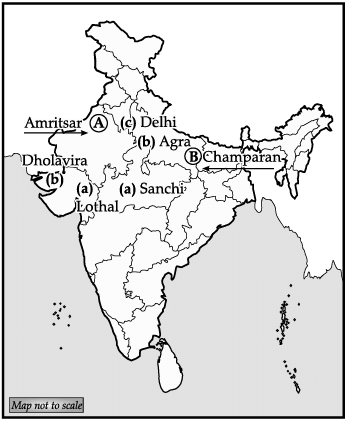
|
30 videos|274 docs|25 tests
|
FAQs on History: CBSE Sample Question Paper (2020-21) - 4 - History Class 12 - Humanities/Arts
| 1. What is the format of the CBSE History Sample Question Paper (2020-21)? |  |
| 2. How many questions are there in the CBSE History Sample Question Paper (2020-21)? |  |
| 3. What is the importance of practicing CBSE History Sample Question Paper (2020-21)? |  |
| 4. Are the questions in the CBSE History Sample Question Paper (2020-21) similar to the actual exam? |  |
| 5. Can the CBSE History Sample Question Paper (2020-21) be used for self-assessment? |  |
















